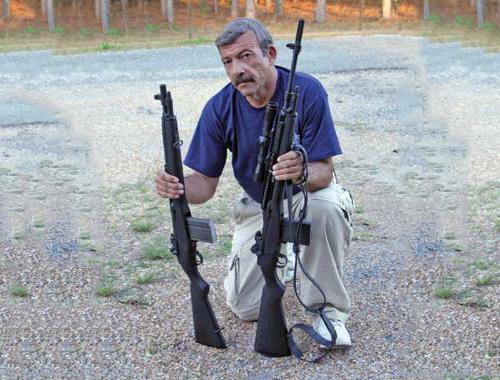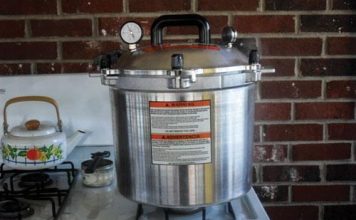 |
|
| Issue #136 • July/August, 2012 |
The person new to guns is like the person new to timepieces. “How many of these things are there?” “In how many configurations?” “And they’ve been around for how long, and no one can decide on a single configuration that’s the best?”
All of which leads to the question, “Which is the right one…and the right size…for me?”
Timepieces or firearms, the answer has always been the same: “It depends what do you need to do with it?”
The timepiece and the firearm have something else in common: evolution makes each smaller and more efficient compared to its forbears in the long history of such devices.
Barrel length in general
The barrel of the gun is generally the part which, more than any other, defines its length. The receiver of a rifle the part that houses the mechanism, or “action” will be built around the length of the cartridge the rifle is intended to fire. In my young days, one advantage of a rifle chambered for the .308 Winchester cartridge over one that fired the older .30-06 Springfield cartridge, was that if you bought it in the classic Winchester Model 70 rifle, the .308 would come with a “short action” and the .30-06 with a “long action.” The difference was insignificant. This shortening paled to what a rifleman achieved if he simply ordered his Model 70 with a 22-inch barrel instead of a 24-inch barrel, in either caliber.
There are basically three issues when dealing with barrel length, and we’ll discuss them here in no particular order because the priority of need differs from shooter to shooter, from mission to mission. Please bear in mind that we’re dealing with generalities here, rules of thumb, in which there will be the occasional exception to the rule.
First, as a rule, the longer barrel allows the gunpowder to burn longer as the shot is fired, building up more pressure and therefore sending the projectile (or, with shotguns, projectiles) out of the muzzle at a higher rate of speed. A faster projectile of the same size and weight (a) hits harder, and (b) takes longer for its trajectory to drop, making it “flatter shooting” an important consideration at longer ranges.
Some students of the gun would see the trajectory factor and the power factor as two separate elements, but since they come from the same source, they are treated as one here.
Second, the optical sight came fairly late to the evolution of the firearm. Original “iron sights” atop the gun were the only index the shooter had to align the barrel with what he wanted to hit. The distance between the rear sight and the front sight, known as “sight radius,” created a classic example of “simple geometry in action.”
Since the variable element of each individual’s vision was involved and also, of course, the ever-present shooter’s curse of “human error” it made sense that the longer the barrel, the better. The rear sight was at the rear of the gun, and the front sight usually just above and behind the muzzle. In other words, the longer the barrel, the longer the sight radius (the distance between the rear and the front of the “iron sights”) and therefore, the less margin for unnoticed human, visual error. Hence the old rule of thumb that the longer the barrel, the more accurately the user could probably shoot.
This is why, from before the first half of the 18th century, through the American Revolution and into the 1830s, your typical soldier’s musket had a barrel measuring about 42 inches in length. The musket itself was, accordingly, so long that if the soldier stood at attention holding his weapon’s butt on the ground next to him, the muzzle of the gun was often taller than he was. Muskets were smoothbores, but American flintlock rifles tended toward long barrels as well, as in the classic nomenclature, “Kentucky Long Rifle.”
Third, and in the 21st century perhaps the most important, there is the matter of convenience of use and deployment. Longer things (which, all other things equal, also tend to be heavier things) are bulkier and altogether more cumbersome to wield when deploying in fast breaking emergencies, or when they must be carried constantly for long periods of time.
Let’s look at how these elements relate to the three types of firearms likely to be found in the backwoods home: the shotgun, the rifle, and the handgun. Each type has different and disproportionate issues related to their typical use which may or may not translate to the other types.
Shotgun barrel length

12-gauge pump shotguns. 20-inch barrel on Remington, left, is much handier than 30-inch barrel on old Winchester ’97 duck gun at right, but latter will develop higher velocity.
When I was a little kid learning guns in the 1950s, my dad explained why the family gun rack contained shotguns (all 12-gauge) with different barrel lengths. The 26-inch Winchester pump gun came standard from the factory with an improved cylinder choke built in, designed to spread the many little birdshot pellets wide on a fast moving partridge or similar bird. The 28-inch barrel had a modified choke which constricted the shot pattern somewhat tighter; one might prefer improved cylinder early in pheasant season, when the birds tended to rise closer to the hunters and their dogs, but by the end of the season the surviving pheasants were the ones smart enough to keep more distance, and you’d need the tighter shot pattern of the modified choke to hit them that far out. The 30-inch barrel Winchester pump gun was in the gun rack for duck season, when the birds you were shooting at tended to be farther out, because the 30-inch barrel and the full choke were then synonymous in the shotgun manufacturing industry, and there were companies making “extra full choke” barrels of 32 inches and even 36 inches length for those who wanted to shoot ducks and geese at farther than typical distances.
I inherited my father’s old shotguns, and they hold a cherished place in my home. But their paradigm is no longer locked in stone. Long before my old body saw daylight, folks in the gun world had figured out that muzzle attachments could allow a single shotgun to adjust the choke pattern. Before my father died, an even more efficient system, screw-in interchangeable choke tubes, was developed. These allowed a shotgunner with a single gun and barrel to adjust the shot pellet pattern much more effectively to his needs on a particular day, stalking a particular quarry. A shooter with a modern 21-inch barrel Remington semiautomatic shotgun can adjust it to perfection for everything from dove to waterfowl, and from near to far.
However, adjusting the pattern of the birdshot’s spread does not accelerate it. Thus, we still see long barrels as the choice on dedicated duck guns and turkey guns. The longer barrel will still let more powder burn, and send the projectiles out faster, and therefore hitting harder.
Rifles
Target rifles, over the centuries, have often been made with barrels of 30 inches or more. When Winchester introduced their most popular lever action rifle in the year 1894, a great many hunters bought it with a 26-inch barrel. However, the single most popular barrel length of the Winchester ’94 over the three centuries it spanned was … 20 inches. The reason for the differing barrel lengths was, quite simply, the differing needs of the people using them.
The longer barrel gave more velocity, flatter trajectory, and a bit more hitting power. However, the shorter barrel was easier to maneuver through the thickets and heavy brush when you were hunting deer in the Eastern forests, and faster to pull from a saddle scabbard if you needed to deploy your rifle out West.
Going back to the Civil War, the optical gunsight was the choice of the rifleman long, long before the shotgunner or the handgunner ever thought of applying it to their firearm of choice. With the telescopic sight doing the aiming, sight radius between front and rear iron sights became irrelevant. In the latter 20th century, “red dot” optics that allowed the shooter to simply place the dot on the target and activate the trigger became popular, and by the first decade of the 21st century, the red dot optic had thoroughly proven itself on the battlefield as well.

Two Springfield Armory M1A rifles, both chambered for .308 Winchester. Short SOCOM-16 version at left is much handier, but shorter barrel reduces .308 velocity to about .300 Savage ballistics.
Once again, the “accuracy” element of the longer barrel had been rendered moot … but there was still the matter of the greater power that a longer barrel could engender in the projectile the rifle put forth.
An interesting example of that factor appeared in the year 1959, when Winchester introduced their .264 Magnum cartridge. It was, in essence, a hot-rodded version of the .270 Winchester cartridge of 1923. With a 140-grain bullet, the .264 Magnum delivered 3510 feet per second velocity and 3183 foot-pounds of energy…but it needed a 26-inch barrel to do it. Shooters noticed that this more powerful rifle was also longer and more awkward to handle when hunting. If its barrel was shortened to the 24 inches of the original Model 54 Winchester .270 of 1923, which had 2916 foot-seconds of velocity and 2,644 foot-pounds of energy with a 140 grain bullet, the difference wasn’t nearly as much.
Bottom line: Today, in the year 2012, the .264 Winchester is pretty much obsolete and hard to find … and the old .270 is still going strong, one of the most popular hunting rifle cartridges even now.
Let’s step away from hunting rifles and go to battle rifles, though there is certainly some crossover there. The .223 Remington/.5.56 mm NATO cartridge the two are very subtly different technically, but so close together practically that they are largely interchangeable hit the scene in the late 1950s/early 1960s, depending on whether you count the time from development or from public awareness and popularity.
When the .223/5.56 got its first real “baptism of fire” in Vietnam, it was in the form of a 55-grain full metal jacket bullet designed to leave the muzzle of the original M16’s 20-inch barrel at 3200 feet per second. The Vietnam conflict was a jungle environment, with conflicts at closer ranges than the average encounters across trench warfare scenarios in WWI or European hedgerows in WWII. Sometimes, the high velocity 5.56mm bullets tumbled and did tremendous damage on enemy soldiers … and sometimes, Americans in the battles found, they just punched .22 caliber holes through their opponents.
During the Vietnam conflict, Colt produced a shorter barrel M16, the CAR-15. These were much handier coming out of a helicopter or crawling through the jungle, but their shorter barrels reduced the velocity of their bullets, and some experts came to believe that the shorter barrels rendered the 5.56mm cartridge less potent. This situation worsened in the War on Terror for two reasons: the US military had in the interim changed cartridge configuration to something designed to be more penetrative against enemy armor and helmets that would likely be encountered in a Cold War battle against the old Soviet Union’s armored troops in Europe, but which didn’t seem as dynamic in the flesh of un-armored enemy soldiers in Iraq or Afghanistan. The US military, now deploying more from vehicles on a mechanized battlefield, went heavily to shorter-barrel M4 rifles. An American fighting man having to maneuver his or her rifle to fight, literally, from the front seat of a HumVee, now very much needed a shorter rifle. The combination of the new ammo and the new demands of freedom of movement on the battlefield resulted in reports that the 5.56mm was no longer as effective in today’s warfare as it had been in conflicts of yesteryear.
For police officers in America, who in a contiguous timeframe were switching from shotguns to .223/5.56mm rifles that they had to deploy from the cramped front seats of patrol cars already filled with radio communications gear and video recording gear and on-board computers, more compact rifles with shorter barrels became an imperative. Police work is also likely to involve opponents ensconced in automobiles. For all these reasons, we are now seeing police trending toward heavier bullets designed to open up at lower velocities from short barrels, and to better penetrate safety glass and auto body metal.
Handguns
For the backwoods home dweller, the handgun serves three purposes. One is destroying animals that threaten the homeowners, their livestock, and their crops. Another is neutralizing a large livestock critter that goes rogue and attacks the humans or the other animals. The third is the same as their city cousins’ need: defending self and loved ones from predatory and homicidal humans. Anyone who reads this magazine and lives the backwoods home lifestyle knows that carrying a rifle or shotgun constantly is not a practical thing … but a handgun in holster or pocket is always there, and is always ready when trouble arrives unannounced.
Barrel length? I think I can honestly say that no one carries a truly long-barrel handgun in their pocket, and with a pretty broad acquaintanceship among armed professionals, I know only one man who carries a 6-inch barrel .44 Magnum on his own backwoods home property, 24/7. (And he’s a pretty big guy, who owns a commercial shooting range and generally can find a good excuse to actually fire that gun on any given day.)

Glock pistols in five barrel lengths. From top: 6 inch (developed for target shooting); 5.43 inch (widely used in match competition, and by some police); 4.5 inch (standard service pistol length); 4.0 inch (suitable for police work or concealed carry); and 3.43 inch (designed mainly for concealment). All shown in 9mm, also available in .40 caliber.
In the 19th century, Western lawmen often carried Colt .45 revolvers and Smith & Wesson equivalents with barrel lengths of 7.5 inches or even longer. By the early 20th century, uniformed police generally wore revolvers with 4- to 6-inch barrels. Patrol cars came on the scene, requiring the man with the holstered gun to sit, and in the first half of the 20th century if you saw a cop with a 6-inch barrel revolver in his uniform holster, it was either on a swivel on his strong side hip (because it was hard to sit down in a car with a gun that long holstered there), or on his opposite hip, “cross draw” with the butt forward, because there it could ride higher and more comfortably, and still be accessible with cross-body draw, almost like reaching for a shoulder holster under the opposite arm.
When we examine the long barrel versus short barrel thing today, we still have to consider the power factor. Longer barrel handguns drive the bullets faster and make them hit harder. However, in handgun ammunition, recent technological developments have “narrowed the gap.” We could make a book in itself out of this aspect, but suffice to say that I’m perfectly comfortable carrying a Glock 30 with a sub-4-inch barrel so long as it is loaded with modern ammunition such as .45 caliber Winchester 230 grain Ranger-T.
Back in the 1980s, when the best we had were conventional copper-jacketed hollow point bullets, I went into a slaughterhouse to test what was then close to state of the art, the 185-grain Federal jacketed hollow point bullet in caliber .45 ACP (Automatic Colt Pistol). I shot three large animals in exactly the same spot, and each were instant humane kills. The first was from a 5-inch barrel Colt Government Model pistol: the bullet expanded into a classic mushroom shape. The second was from a 4.25-inch barrel Colt Commander pistol: the bullet deformed at the lower velocity from the shorter barrel pistol, but it finished with a much smaller diameter. The third shot with the same ammo came from a Colt Officers pistol with only a 3.5-inch barrel, and when recovered from the dead animal was found to have not expanded at all. We could have literally wiped the meat and blood off the projectile, reloaded it into another cartridge, and fired it again. Today’s modern .45 ammunition in the high tech designs such as Federal HST, Remington Golden Saber, Speer Gold Dot (particularly their Short Barrel load), and Winchester Ranger and PDX are all designed to open at lower velocity windows when fired from short barrel concealment guns.
For hunting handguns, I like revolvers. I own .44 Magnum revolvers with 3-inch, 4-inch, 6.5-inch, and 83/8-inch barrels, and even a Thompson/Center Contender single shot .44 Magnum pistol with a 14-inch barrel. The longer ones would be the logical choices for dedicated hunting handguns, but the .44s I found myself killing game with over the years were the 4-inch Smith & Wessons. The reason was simple. In Africa, I needed a sidearm powerful enough for dangerous animals if I couldn’t get at my .375 Magnum Steyr rifle or my Ruger .458 elephant gun, but also something compact enough to carry concealed in the dangerous city streets of Pretoria or Johannesburg. The 4-inch Model 629 stainless one year, and the 4-inch blue Model 29 the next time, fit that bill…and a longer barreled handgun simply did not.
I had learned a cardinal disadvantage of very long barrels when I was about 16. I had been deer hunting in a time and place where it was legal to shoot fox, and I was carrying my 83/8-inch barrel Smith & Wesson Model 27 .357 Magnum legally loaded and exposed on my hip, to back up my Winchester .308 hunting rifle. At end of day, back at the car, I unloaded and cased the .308 and put it in the back seat. Getting into my ’55 Pontiac and closing the door, I remembered it was time to unload the revolver before I got back on the main road.
At about that moment, I spotted a handsome red fox crossing the logging road ahead and to the left of my parked car. Thinking that he’d make an impressive stole for my girlfriend, I slipped the long-barrel .357 out of my holster with my right hand, and as slowly and quietly as I could, hand-cranked the driver’s window down with my left. The animal made eye contact with me, and I knew it had to be now or never. I swung the big S&W over the steering wheel…
And the long barrel loudly and suddenly clanged against the steel “wind wing” window in front of the open main car door window. The fox was off like a shot like the shot I didn’t get off before I could maneuver that long-barrel six-shooter out the window and get a sight picture on him. Fox 1, me 0 … and a lesson learned.
In the end, whether we’re talking rifle or shotgun or handgun, barrel length is a balance between the longer gun’s greater accuracy (at least in terms of iron sights), and the higher velocity it may afford, and the distinctly greater handling ease and convenience, especially in tight brush or other close quarters, that comes with a shorter gun.
You assess your needs, you lay down your money, and you make your choice.















One thing to consider is that now (2022) modern propellants have evolved to create higher velocities, and therefore higher downrange energy, from shorter “carbine” length (and shorter) barrels. Add to that, new bullet designs (i.e. ballistic tip etc) and a 16″ barrel will deliver extreme penetration, accuracy and expansion compared to longer barrels. Several clibers (.300aac; .458 socom) were specifically designed for short (sub 16″) barrels.
As always, a great article.